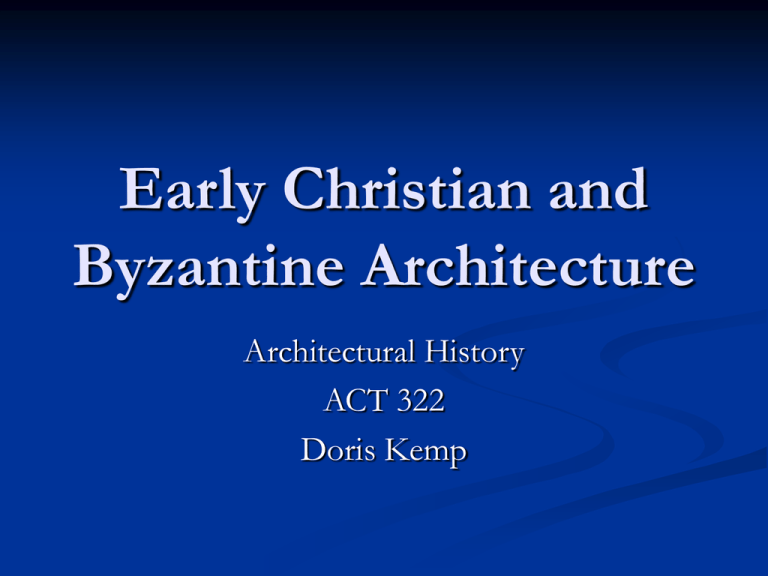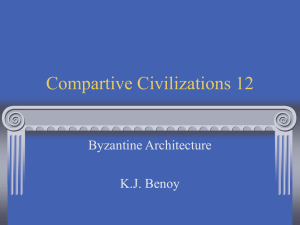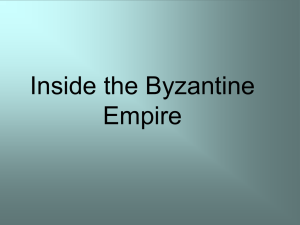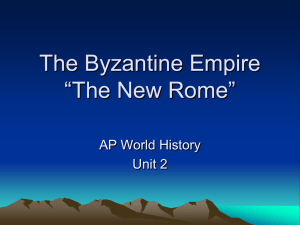Early Christian and Byzantine Architecture
advertisement

Early Christian and Byzantine Architecture Architectural History ACT 322 Doris Kemp Topics Byzantine Architecture The Ideal Byzantine Church Central Plan Domes Lighting and Decoration Hagia Sophia Other Justinian Structures Byzantine Architecture In the years around 500 A.D. the Western Empire laid in ruins Rome had been sacked twice and Italy was in the hands of the Ostrogoths The Eastern Empire lived on Constantinople was the capitol of the Eastern Empire Had been built on the Hellenic city of Byzantium (modern day Istanbul, Turkey) Byzantine Architecture A formal shift from early Christian to Byzantine architecture can be seen in the early sixth century A.D. Timber-roofed Latin basilican churches gave way to domed, central-plan structures in the Eastern Empire Byzantine Architecture: Ideal Byzantine Church No two Byzantine churches were identical Features of the ideal Byzantine church: Central plan Pendentive dome String focus on structure, lighting, and elaborate decoration Byzantine Architecture: Ideal Byzantine Church Central Plan The axis descended away from visitors Leaves no possible active participation except weakly around a central axis In most Byzantine churches, the centralized building core was square Byzantine Architecture: Ideal Byzantine Church Domes Central core of the church formed an integral part of a larger structure that included supporting structure and vaulting as well The dome complimented the spatial core of the church Domes were generally placed over cylinders, as at the Pantheon Byzantine Architecture: Ideal Byzantine Church Domes Occasionally, domes were placed over polygons or even squares Created certain structural problems Pendentive Provided a way to set a circle (dome) atop a square A Roman invention, though rarely used Byzantines used pendentives very often Domes were used to invoke powerful images of the Christian heaven Byzantine Architecture: Ideal Byzantine Church Photo: Sullivan Byzantine Architecture: Ideal Byzantine Church Lighting and Decoration Articulation was very important in Byzantine architecture No visible surfaces were left in a natural state All was dissolved in color and light: Glowing marble pavements Richly veined marble walls Extensive mosaic cycles Rich patterns of light created by glass and structural features Byzantine Architecture: Ideal Byzantine Church Photo: Sullivan Byzantine Architecture: Hagia Sophia Hagia Sophia Symbolizes the “ideal” Byzantine church Built as the new Cathedral of Constantinople by the Emperor Justinian in 532 – 537 A.D. Intended to be the keystone of Justinian’s massive architectural campaign Byzantine Architecture: Hagia Sophia Photo: Sullivan Byzantine Architecture: Hagia Sophia Hagia Sophia Justinian believed that only natural scientists and philosophers would be able to create the structure he had seen in his dreams Designed by two men: Anthemius of Tralles Natural scientist Mathematician Isidorus of Miletus Professor of stereometry and physics at Constantinople Byzantine Architecture: Hagia Sophia Photo: Sullivan Byzantine Architecture: Hagia Sophia Hagia Sophia Built in an amazing five years Its first dome was destroyed by an earthquake and rebuilt in 563 A.D. Was converted to a mosque by the Ottoman Turks Byzantine Architecture: Hagia Sophia Hagia Sophia Has some structural problems Main piers are of excellent solidarity, built of massive ashlar masonry Rest of the building, however, was built of brick in thick mortar beds The dome generates tremendous pressure Corners are supported by pendentives but the sides have little support Byzantine Architecture: Hagia Sophia Photo: Sullivan Byzantine Architecture: Hagia Sophia Photo: Sullivan Byzantine Architecture: Other Justinian Structures No other Byzantine churches approach even half the scale of Hagia Sophia Two churches bear a resemblance to Hagia Sophia SS. Sergious and Bacchus S. Vitale Byzantine Architecture: Other Justinian Structures SS. Sergius and Bacchus Located in Constantinople Built as a palace chapel between 527 and 536 Many historians believe it was an experimental version of the Hagia Sophia Byzantine Architecture: Other Justinian Structures Photo: Sullivan Byzantine Architecture: Other Justinian Structures S. Vitale Located in Ravenna, Italy Very precise and strict double-shell form that featured a dome Featured mosaics of Justinian and his queen, Theodora, and their court Byzantine Architecture: Other Justinian Structures Photo: Sullivan Byzantine Architecture: Other Justinian Structures Church of St. John the Evangelist Built at his tomb in the Hellenistic city of Ephesus on the coast of Asia Minor c. 548 A.D. Photo: Sullivan Byzantine Architecture: Other Justinian Structures S. Marco Located in Venice, Italy Although built in the Romanesque Period (c. 1063 – 1094), it is considered more Byzantine in style than Romanesque Photo: Sullivan References Sullivan, Mary; http://www.bluffton.edu/~sullivanm/ http://www.brynmawr.edu/Acads/Cities/wld/wdpt1.html Trachtenburg/Hyman; Architecture: From Prehistory to Postmodernity Wodehouse/Moffett; A History of Western Architecture Early Christian and Byzantine Architecture Architectural History ACT 322 Doris Kemp










